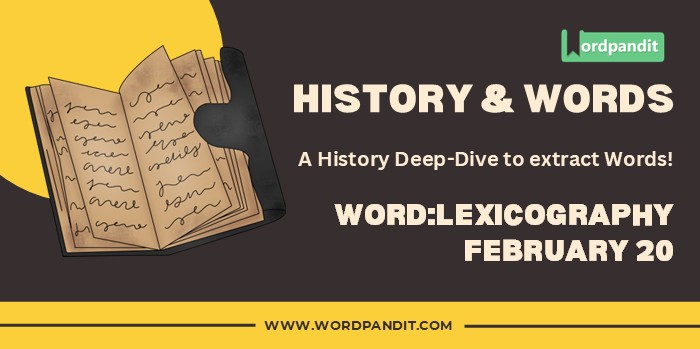History & Words: ‘Lexicography’ (February 20)
Welcome to ‘History & Words.’ 🌟 I’m Prashant, founder of Wordpandit and the Learning Inc. Network. This series combines my passion for language learning with historical context. Each entry explores a word’s significance on a specific date, enhancing vocabulary while deepening understanding of history. Join me in this journey of words through time.
📚 Table of Contents
🔍 Word of the Day: Lexicography
Pronunciation: /ˌlɛksɪˈkɒɡrəfi/ (lek-si-KOG-ruh-fee)
🌍 Introduction
On February 20, 1725, Samuel Johnson, one of history’s most influential lexicographers, was born in Lichfield, England. His monumental “Dictionary of the English Language”, published in 1755, revolutionized the way we document and understand language, establishing standards that would influence dictionary-making for centuries to come.
The word “lexicography” represents more than just dictionary compilation; it embodies the systematic study of word meaning, usage, and evolution. Johnson’s birth date provides an excellent opportunity to explore this fascinating field that bridges linguistics, history, and cultural documentation.
The art and science of lexicography has shaped how we preserve, understand, and transmit language across generations, making it a cornerstone of cultural preservation and linguistic scholarship.
🌱 Etymology
The word “lexicography” combines two Greek elements: “lexis” meaning “word” or “speech“, and “graphia” meaning “writing“. The term emerged in the early 17th century as the practice of dictionary-making became more systematic and scholarly, though the activity itself dates back to ancient civilizations.
📖 Key Vocabulary
- 🔑 Lemma: The canonical (dictionary) form of a word, such as the infinitive for verbs or singular for nouns, used as the headword in dictionary entries.
- 🔑 Corpus: A large collection of texts used by lexicographers to study word usage and meaning in context.
- 🔑 Polysemy: The existence of multiple meanings for a single word, which lexicographers must carefully document and distinguish.
- 🔑 Etymology: The study of word origins and evolution, a crucial component of comprehensive dictionary entries.
🏛️ Historical Context
The practice of compiling word lists and their meanings dates back to ancient Mesopotamia, where clay tablets preserved bilingual word lists in Sumerian and Akkadian. These early attempts at lexicography served practical needs in administration, education, and translation.
In medieval Europe, glossaries emerged to help readers understand difficult or foreign words in religious texts. These glossaries gradually evolved into more comprehensive works, though they often focused on specialized vocabulary or biblical terms.
The Renaissance brought a surge in lexicographical work as scholars sought to document and standardize national languages. This period saw the emergence of monolingual dictionaries, marking a shift from earlier bilingual works focused on Latin and Greek.
⏳ Timeline
- 2300 BCE: Earliest known bilingual word lists in Mesopotamia
- 1225: First known English-French glossary
- 1604: Robert Cawdrey publishes first English dictionary
- 1725: Birth of Samuel Johnson
- 1755: Publication of Johnson’s Dictionary of the English Language
- 1828: Noah Webster publishes American Dictionary of the English Language
- 1857: Work begins on the Oxford English Dictionary
- 1884: First fascicle of Oxford English Dictionary published
- 1928: Completion of first Oxford English Dictionary
- 1961: Webster’s Third New International Dictionary published
🌟 The Day’s Significance
February 20, 1725, marks the birth of Samuel Johnson, whose work would transform English lexicography. Johnson’s dictionary, completed in nine years with minimal assistance, set new standards for accuracy, comprehensiveness, and scholarly rigor in dictionary-making.
Johnson introduced several innovations that became standard practice:
- The use of illustrative quotations to demonstrate word usage
- Careful distinction between different word senses
- Inclusion of technical and scientific terminology
His work also helped standardize English spelling during a period of considerable orthographic variation.
The significance of Johnson’s birth extends beyond his personal achievements. It represents a pivotal moment in the development of modern lexicography, marking the transition from simple word lists to scholarly works that documented language usage with precision and authority.
💬 Quote
“Every quotation contributes something to the stability or enlargement of the language.” – Samuel Johnson
🔮 Modern Usage and Reflection
Today, lexicography has evolved into a sophisticated field combining traditional scholarship with digital technologies. Modern lexicographers use vast electronic corpora and advanced software tools to track language changes and document new words and meanings.
The principles established by Johnson and his successors continue to guide dictionary-making, though the focus has shifted from prescriptive to descriptive approaches, acknowledging language as a living, evolving system.
🏛️ Legacy
The legacy of systematic lexicography extends far beyond dictionary production. It has contributed to:
- Language standardization: Ensuring consistency in spelling, pronunciation, and grammar
- Education: Helping learners understand word meanings and usage
- Cross-cultural communication: Bridging linguistic gaps in translation and multilingual societies
With the rise of digital lexicography, access to dictionaries has been democratized, allowing anyone with an internet connection to explore the depths of a language. However, new challenges have also emerged, such as the rapid pace of language evolution and the need for lexicographers to track informal and slang expressions in real-time.
🔍 Comparative Analysis
While early lexicography focused primarily on defining words and standardizing spelling, modern lexicography encompasses a broader scope, including pronunciation, etymology, usage notes, and regional variations. The field has evolved from a solitary scholarly pursuit to a collaborative enterprise involving linguists, data scientists, and subject matter experts.
Unlike traditional printed dictionaries, which were updated infrequently, today’s digital dictionaries are constantly revised to reflect the dynamic nature of language. The internet has enabled users to contribute to linguistic databases, making modern lexicography a more interactive and community-driven process.
💡 Did You Know?
🎓 Conclusion
The birth of Samuel Johnson serves as a reminder of lexicography’s crucial role in preserving and understanding language. His work laid the foundation for modern dictionary-making, emphasizing the need for accuracy, clarity, and depth in documenting words.
As we continue to witness rapid linguistic evolution in the digital age, the principles of careful documentation and analysis established by early lexicographers remain vital to our understanding of language and its development.
📚 Further Reading
- 📘 The Story of Webster’s Third: Philip Gove’s Controversial Dictionary and Its Critics by Herbert C. Morton
- 📗 Defining the World: The Extraordinary Story of Dr Johnson’s Dictionary by Henry Hitchings
- 📙 The Professor and the Madman: A Tale of Murder, Insanity, and the Making of the Oxford English Dictionary by Simon Winchester












